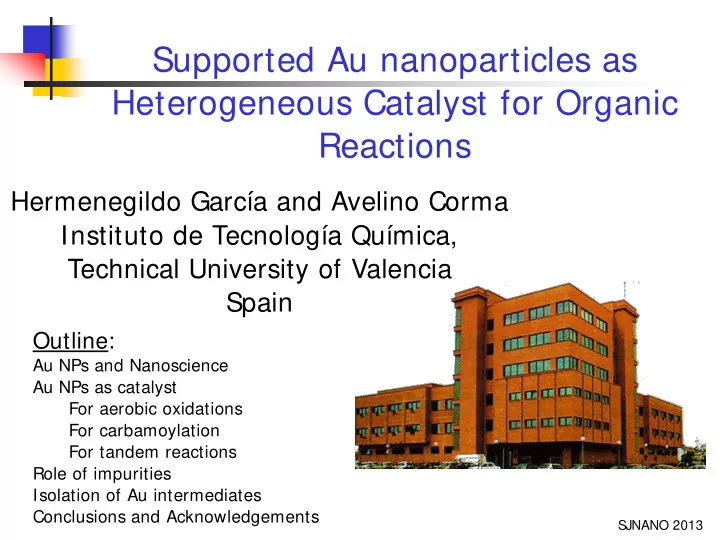

Supported Au nanoparticles as Heterogeneous Catalyst for Organic Reactions Hermenegildo García and Avelino Corma Instituto de Tecnología Química, Technical University of Valencia Spain Outline: Au NPs and Nanoscience Au NPs as catalyst For aerobic oxidations For carbamoylation For tandem reactions Role of impurities Isolation of Au intermediates Conclusions and Acknowledgements SJNANO 2013
Catalytic activity of noble metals Why not gold? As the only exception in noble metals up to the 80s Au was catalytically inactive
Gold nanoparticles as catalyst Hydrogen technology H 2 O CO 2 + H 2 CO + H 2 C + H 2 O water gas shift syngas Low temperature, selective CO combustion: the smaller the particle size, the higher the activity Au CO 2 CO + O 2 M Haruta, N Yamada, T Kobayashi, S Iijima: J. Cat. 115 (1989) 301-09.
Au NPs They can be easily obtained. “Bare” small Au NPs (1 -2 nm) tend to grow The key issue is to stabilize small Au NPs “Stabilized” nanoparticles are surrounded by a ligand shell or supported on a solid Typically, for bulk materials, surface atoms form a negligible part of the total 20 nm number of atoms
Stabilizing Gold Nanoparticles Use of ligands (Brust method) 1.4 nm Gold Particles PTC PPh 3 NaBH 4 HAuCl 4 Supporting on a solid: Deposition-Precipitation method NH 4 OH CH 3 OH HAuCl 4 Au(OH) 3 Au nanoparticles
Organic reaction types Brönsted acids Hydrogenations N OH O H 2 H H 2 SO 4 N Pd/C (oleum) Bases Lewis acids O CH 3 O O NaOH CH 3 CH 3 (CH 3 CO) 2 O CH 3 CH 3 CH 3 AlCl 3 Transition metal catalysts Oxidations HO B OH O H OH Br K 2 CrO 4 CH 3 CH 3 CH 3 CH 3 Pd
Au NPs supported on nanoparticulated ceria CeO 2 nanoparticles • Increasing Ce III population • Creation of oxygen vacancies • From insulator to semiconductor Particle size distribution Interplanar distance of Au 40 Counts 20 0 0 1 2 3 4 5 6 7 8 9 10 11 12 13 14 15 Diameter (nm)
Solventless, aerobic (1 atm) oxidation of alcohols by Au/CeO 2 Conversion [a] Time Substrate Product Selectivity[%] [h] [%] 1 b 3-octanol 2.5 97 3-octanone 96 2 b sec-phenylethanol 2.5 92 acetophenone 97 3 b 2,6-dimethylcyclohexanol 2.5 78 2,6-dimethylcyclohexanone 94 4 b 1-octen-3-ol 3.5 80 1-octen-3-ona >99 5 b cinnamylalcohol 7 66 cinnamaldehyde 73 6 b 3,4-dimethoxybenzyl alcohol 7 73 3,4-dimethoxybenzaldehyde 83 7 b 3-phenyl-1-propanol 6 70 3-phenylpropyl- 3-phenylpropanoate 98 8 c vanillin alcohol 2 96 vanillin 98 9 c 2-hydroxybenzyl alcohol 2 >99 2-hydroxybenzaldehyde 87 10 c 3,4-dimethoxybenzyl alcohol 2 >99 3,4-dimethoxybenzylic acid >99 11 c cinnamyl alcohol 3 >99 cinnamylic acid 98 12 d n-hexanol 10 >99 hexanoic acid >99 13 e n-hexanol 10 >99 hexanoic acid >99 14 c sec-phenylethanol 5 >99 acetophenone 51
Solventless aerobic alcohol oxidation and the green chemistry principles Avoid wastes (minimise E factor) . 1. Use tolerable reagents and produce non-toxic 2. products . Use environmental friendly processes . 3. Use renewable feedstocks. 4. Develop more active and selective catalysts. 5. Avoid derivatisation, protecting groups and isolations. 6. Maximise the atomic economy. 7. Use environmentally friendly solvents. 8. Minimise energy consumption 9. Use self- or bio- degradable products 10. Real time analyses 11. Minimise hazards 12.
Replacement of toxic phosgene: Catalytic carbamoylation of aromatic diamines polyol phosgene polyurethanes (Best selling industrial isocyanate polymers) • Problem: development of a catalyst
Carbamoylation of 2,4-diaminotoluene 100 Product selectivity (%) 75 50 25 Final yield > 90% 0 0 1 2 3 4 5 6 7 t(ht) Au NPs on other supports give rise to N-methylation products:
Tandem reaction Two steps, two processes : O CH 3 CH 3 CH 3 H H 3 C C CH 3 H 2 N C O CH 3 NO 2 NH 2 O O O HN O CH 3 NO 2 NH 2 C O or two-steps one process : CH 3 H CH 3 N O NO 2 H 2 (5 bar) O DMC T=150ºC HN O t=12 hours NO 2 O Conversion = 95.2 Selectivity = 98.3
Role of Pd impurities in Au catalysis • Pd is a very efficient catalyst • Au contains 5-10 ppm of Pd • Has Au intrinsic activity ? High purity Au is also active for • Au complexes of a single atom is not able Sonogashira coupling to promote Sonogashira • Au NPs are active
Isolation of Au intermediates Au catalyst
Conclusions and Acknowledgements Supported small sized Au NPs are highly active catalysts Prof. Avelino Corma Dr. Alberto Abad Dr. Raquel Juárez Dr. Abdessamad Grirrane Financial Support: • Japanish-Spanish Cooperative program
Recommend
More recommend